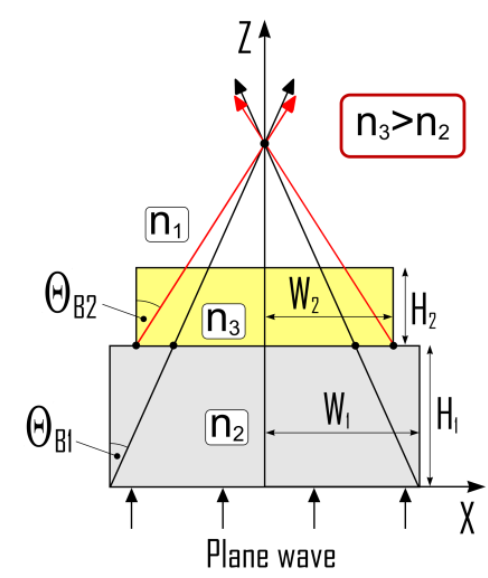
In this paper, we report the experimental and numerical investigation of plane wave diffraction by an all-dielectric dual-material cuboid. Edge diffraction by a cuboid leads to the generation of a narrow, high intensity beam in the near-field region called a photonic jet. We examine the dependence of the jet behavior and orientation on the materials and dimensions of constitutive parts in the microwave frequency domain. The possibility to shift and deviate the resultant microwave jet in the near-field region of such a structure depending on the size of constitutive parts is demonstrated numerically. Experimentally, we observe a shift in the spatial position of the jet. The experimental asymmetric electric field profile observed in the far-field region is attributed to the input of multiple edge waves generated by the dual-material cuboid. The presented results may be scaled at different frequency bands such as optical frequencies for designing nanostructures enabling the focusing and deviation functionality and creation of new optical devices which would satisfy the needs of emerging nanophotonic applications.
“Experimental observation of asymmetrical microwave jets and far-field distribution generated by a dual-material system“, B. Varghese1, , O. Shramkova1, P. Minard2, L. Blondé1, V. Drazic1, V. Allié1, Scientific reports, june 2021.

In this work we have developed new types of color splitters, which separate spectrally and spatially the light that falls on image sensors by exploiting the nanojet (NJ) beam phenomenon. The proposed method relies on light diffraction on the edges of constitutive parts of the studied multi-material elements embedded in a host medium with lower refractive index. Diffraction of light on the edge of a dielectric microstructure forms a tilted focused beam whose deviation angle depends on the refractive index ratio between the materials of the elements creating this edge. The characteristics of the generated NJ beams are also controlled by the geometry of multi-material elements (size and base angle of the edge) and the angle of wave incidence. Combination of two or more dielectric materials with different refractive indexes leads to the creation of multiple NJs with different angles of deviation, length and intensity. In the case of normally incident plane wave, the generated NJ beams originating from different edges of the constitutive parts of a multi-material microstructure, recombine and contribute to the formation of NJ beam deflection away from the normal direction in the near zone. The possibility to split color-bands of the incident light by combining two or more dielectric materials in such a way that the generated NJ beams create a spectrally dependent NJ beam deflection is discussed. We demonstrate that the proposed topologies of multi-material microlenses help to reduce the size of the color splitting element and optical crosstalk through the active Si layer. We show that the color splitting functionality of the proposed exists for inclined incident light as well. Applying these color splitters to actual image sensors allows to improve the optical efficiency by splitting the incoming light between the image sensor pixels, instead of filtering out part of the received light.
“Nanojet-based dielectric multi-material color splitters for image sensor applications.“, Oksana Shramkova*, Valter Drazic, Laurent Blondé, Bobin Varghese, Valérie Allié, SPIE Photonics Europe, April 2020, Strasbourg, France (Online).

In this paper we study high-intensity nanojet (NJ) beams generated at the output of dielectric multi-material elements. The proposed method for generating condensed optical NJ beams relies on the complex electromagnetic phenomenon associated with the light diffraction on the edges of constitutive parts of the studied system embedded in a host medium with lower refractive index. The possibility of NJ shift and deviation in the near zone of such a microstructure illuminated by a plane wave is demonstrated via a double-material microstructure. We examine the dependence of NJ beam behavior and orientation on the materials and dimensions of the constitutive parts.
“Photonic nanojet generated by dielectric multi-material microstructures.“, Oksana Shramkova*, Laurent Blondé, Valter Drazic, Bobin Varghese, Valérie Allié , META July 2019, Lisbon, Portugal.

The diffraction of light from a right-angled, lossless dielectric step, illuminated by a plane wave, forms a tilted focused beam. Its deviation angle depends on the index ratio between the structure material and host medium. This paper will demonstrate the existence of a critical height of a wavelength sized edge. This edge diffracts the incident light energy inside the higher index medium, as a specific field distribution. The analysis, done for optical frequencies, identifies lobes in the resulting field distribution. The lobes repartition is driven by a critical height and its multiples. These EM patterns are evaluated in relation with the photonic nanojet phenomenon.
“Influence of an edge height on the diffracted EM field distribution“, Bobin Varghese, Oksana Shramkova, Valter Drazic, Valérie Allié, Laurent Blondé*, International Conference on Transparent Optical Networks, 9-13 July 2019, Angers, France.

In this contribution we reveal how the step-like topology of a microstructure can contribute to the formation of a single high-intensity nanojet (NJ) beam located on its axis of symmetry. The proposed method for generating condensed optical NJ beams relies on the complex electromagnetic phenomenon associated with the light diffraction on the edges of step-like dielectric microstructures embedded in a host medium with lower refractive index. The possibility of NJ beam intensification in the near zone of such microstructure illuminated by a plane wave is demonstrated and explained by the recombination of multiple NJ beams associated with different edges or edge segments of the step-like microlens. We demonstrate that by changing materials of the layers we can intensify the NJ beam. We examine the dependence of the generated beam on the step size, shape and material.
“Localized photonic jets generated by step-like dielectric microstructures“, O. Shramkova, V. Drazic, M. Damghanian, A. Boriskin, V. Allié, L. Blondé, International Conference on Transparent Optical Networks, 1-5 July 2018, Bucharest, Romania.




